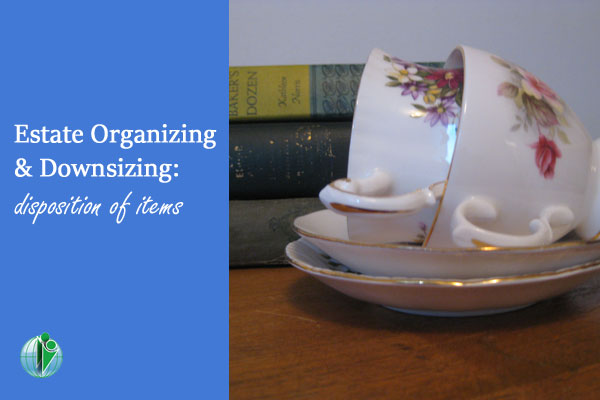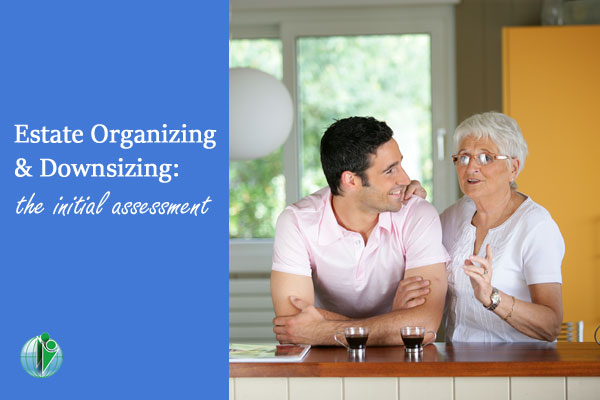Estate Organizing & Downsizing: Disposition of Items
This page may contain links to Amazon.com or other sites from which I may receive commission on purchases you make after clicking on such links. Read my full Disclosure Policy

Last week, Linda Vanderkolk shared her method for conducting an initial assessment when working with clients who are downsizing to a smaller home. Today she’s back with tips to help you guide your clients through the next step in the process.

Once you’ve identified which items your client will be taking to their new home, and which will be given to family members, it’s time to deal with the remaining items. These can be assigned to categories, such as items to sell, donate, and dispose of. Before discussing these categories, it is important to express to all family members that it is okay to let go of possessions and let someone else become the caretaker of these items.
Honouring Treasures
What may have been important to one person may not be important to another. The real way to honour an individual is not by what they have or owned, but by what was shared in terms of memories and events. Now is the time to determine what is most meaningful and important and provide your clients with creative ways to treasure those memories without needing to take every possession. It’s helpful to advise your client that by cutting through the clutter, the treasures that are most meaningful will have more space in the new home so they can be treasured even more.
You will find that some elderly clients are ready to let go while others will hold onto items for dear life and not truly understand that they just can’t take three sets of dishes to their new home, or bring that beloved, overstuffed chair from Great Aunt Hilda, because it takes up 20% of the living space. Cognitive distortions can keep clients trapped in patterns that will not serve them well moving forward. You will need to honour the way your client’s brain thinks and reposition statements of fear for them as you begin to deal with common rationalizations that will ultimately surface when you sort through belongings.
Disposition of items
Disposing of items can be a daunting task for the family. Some of the issues that can arise are not knowing where to sell items, not knowing the value of the items, and not being able to let go. There are several options available to you and your clients in this regard.
They include, but are not limited to, holding an open house type of sale, holding an estate sale through a professional service, holding a live or website auction or selling the entire lot to a liquidator. If you are unsure of the value of an item there are many professionals who can give you a fair market value for the goods such as antique dealers, consignment shops, used sporting goods stores, etc. Your client is relying on you, so first and foremost ensure you are dealing with reputable individuals.
For donations, there are many charities that welcome household goods to be given to families in need. Some charities will accept almost anything while some are very selective. Make detailed inquiries. Finding out what charity the family supports will make the decision to donate that much easier.
Consignment is another option for remaining goods. A consignment shop will want to view any items before they agree to take them in. It will be your responsibility to arrange for the items to be delivered to the shop for viewing. Better yet, take photos of the items and email them to the shop with as many details and distinguishing marks as possible. Expect that some items will be deemed of no value or interest from the consignment shop due to market demands, wear and tear, too much existing inventory, not a good fit for the community, or various other reasons. Encourage your clients not to take this personally as it is no reflection on them or the item itself.
Discarding of remaining goods
Once you have determined what is to be sold, donated, consigned or passed on to family, the items remaining will need to be dealt with. It may be of little or no value but you must still ensure that those items are disposed of with discretion and thought to your client, as you never know what may hold sentimental value to your client or their family.
You may have a very large volume of items for disposal, in which case you will need to source and arrange for a waste disposal bin or truck to cart items away. Of course, you will have discussed all of this with your clients during the assessment process so that they are not surprised by additional costs to the project.
Some other items you will have to deal with as project manager are scrap metal for which you can arrange for free pick up and removal, toxic waste to be delivered to the local hazardous waste disposal site, and pharmaceutical waste to be disposed of in an environmentally safe way.
You may have many other tasks to manage with this type of project including sourcing for new furniture, arranging for the purchase and delivery of packing materials, packing, arranging for and supervising the move, arranging for the shredding of confidential documents and locating vital papers.
Don’t be surprised as you come across resistance along the way. Sometimes elderly clients need a little encouragement and motivation in these projects. One way I do that is to suggest that the preparation of a move to a smaller home is the first step of a fresh start, a new chapter in their lives and perhaps an even greater adventure!
Working with older adults and families in an estate or bereavement situation is one of the most rewarding aspects of my work. I love large projects and the detail that goes along with it. Working collaboratively I have helped hundreds of clients make decisions on what to keep, what to pass on to family and what to discard. Preparation and effective project management is my key to a successful project, managing all the details, retaining precious memories while streamlining for a simpler and more efficient lifestyle.




This can be such a difficult process. My experience is that many people struggle with the reality that there is no market for items they treasure (either because they paid or a lot, they were expensive gifts, or they have great sentimental value.) Sets of china and silver and dark work furniture are some of the common culprits. It is a lesson to me about keeping items for my children… they may end up not wanting them!
I think the hardest part of downsizing my estate would be getting rid of things. I’m not a compulsive hoarder like you see on TV, but I do have a lot of things that are meaningful to me that I have kept for a long time. Hopefully I’ll be able to go through them this holiday season and really just sort out the things that are most important! Thanks for this reminder!